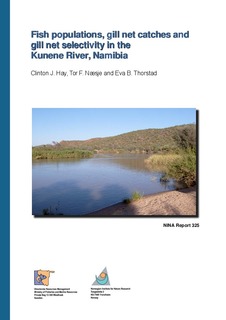Fish populations, gill net catches and gill net selectivity in the Kunene River, Namibia
Research report

Åpne
Permanent lenke
http://hdl.handle.net/11250/2449863Utgivelsesdato
2008Metadata
Vis full innførselSamlinger
- NINA Rapport/NINA Report [2341]
- Publikasjoner fra CRIStin - NINA [2364]
Sammendrag
Hay, C.J., Næsje, T.F. & Thorstad, E.B. 2008. Fish populations, gill net catches and gill net selectivity in the Kunene River, Namibia. - NINA Report 325. 98 pp.
The Kunene River The Kunene River originates near Huambo in Angola, from where it flows in a southerly direction towards Namibia. The catchment area is 107000 km2. In Angola, the upper reaches are relatively steep, while the middle sections form floodplain habitats. Once the river reaches Ruacana in Namibia, it turns west towards the sea, forming the border between Angola and Namibia for a distance of approximately 340 km. Floodplains are absent along the Namibian section. Objective The objective of this report is to provide baseline information about the fish resources in the Kunene River to form the biological foundation for recommendations for a sustainable management. Based on fish survey data from the period 1994-2004, the fish resources are described through studies of species diversity, relative importance of the different species, life history parameters, catch per unit effort and gill net selectivity. Methods Fish were collected at 18 locations with gill nets and seven other sampling methods (collectively called “other gears”), such as seine nets, cast nets, electrofishing apparatus and rotenone. The gill nets (22-150 mm mesh size) were used to survey open, deep-water habitats in the main stream near the shore and in deep backwater areas. Other gears targeted mainly small species and juveniles in shallow, vegetated and rocky habitats. Ten surveys were carried out in the period 1994-2004. A total of 16959 fish were caught, of which 6862 with multi-filament gill nets and 10097 with other gears. The most important species were identified by using an index of relative importance (IRI), which is a measure of the relative abundance or commonness of the species based on number and mass of individuals in the catches, as well as their frequency of occurrence. Results A total of 50 fish species were identified, of which four were marine species. In addition, Synodontis spp., an unknown freshwater species, an unknown marine species and Gobii-dae spp. were recorded. The families represented with the highest number of species were the Cyprinidae and Cichlidae, with 14 and 12 species, respectively. Southern Africa, Namibia, Kunene River fish populations, life history, CPUE, gill net selectivity, fish surveys, management of fisheries, fish diversity